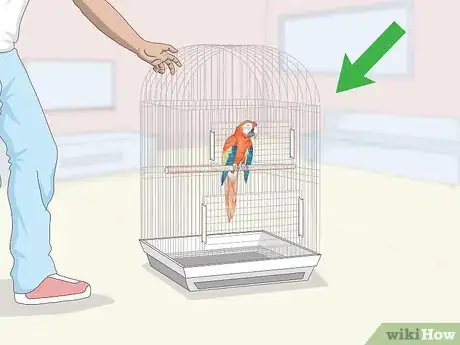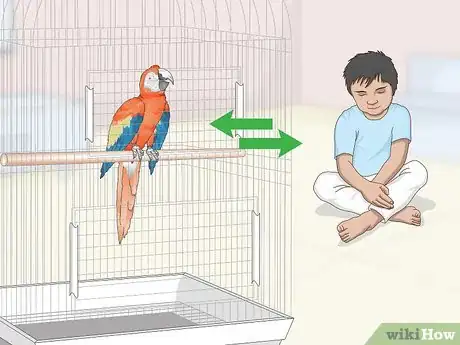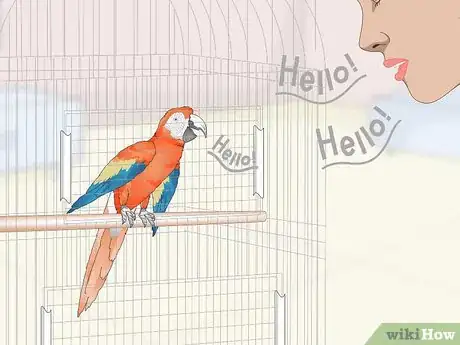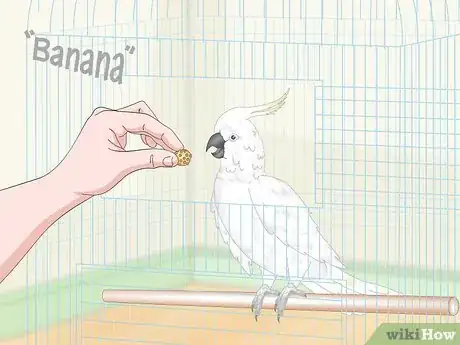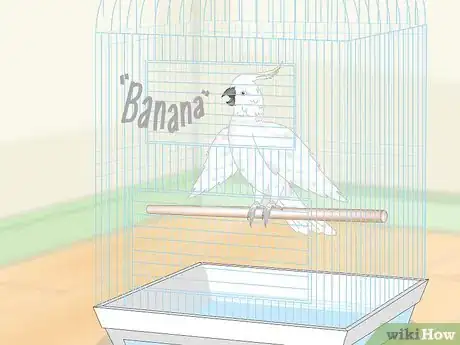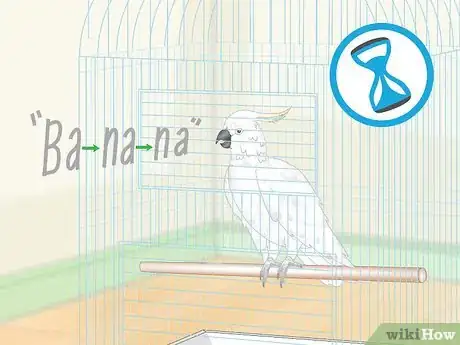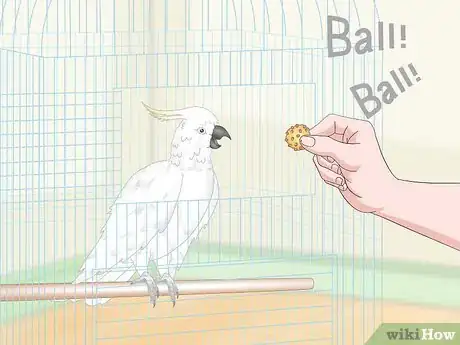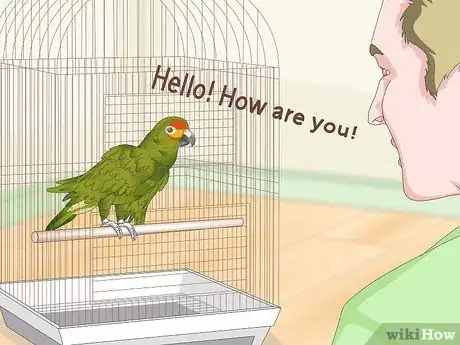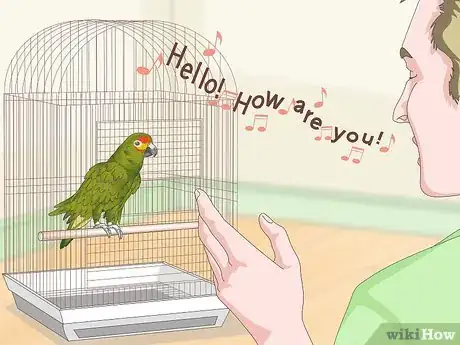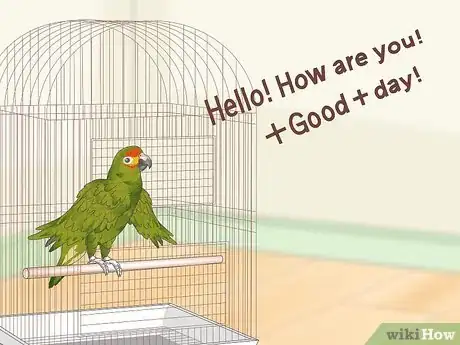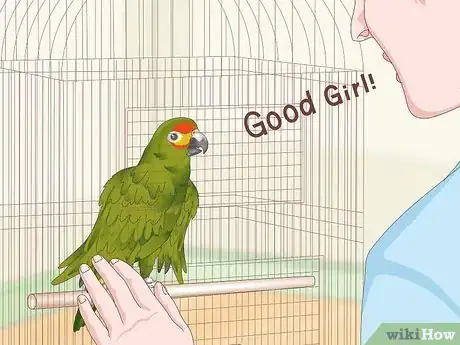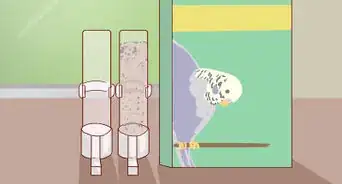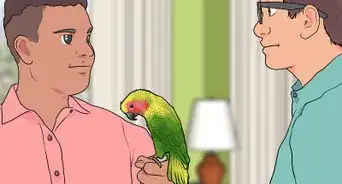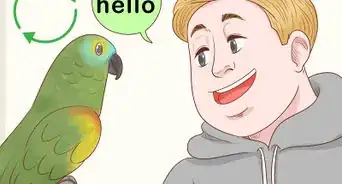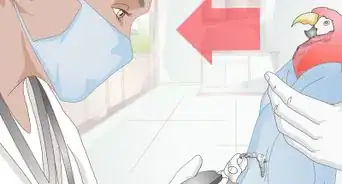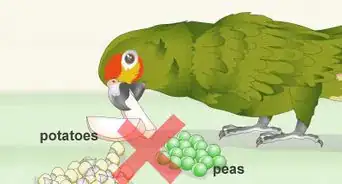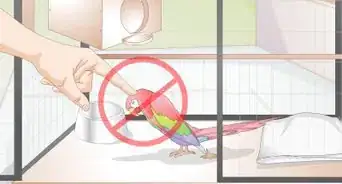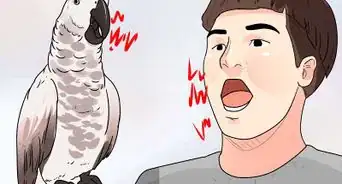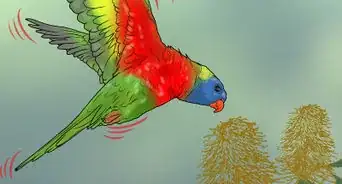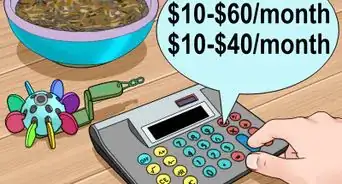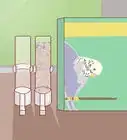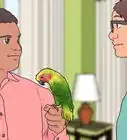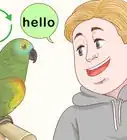This article was co-authored by Hayley Heartfield. Hayley Heartfield is a Bird Specialist and the Owner of About Birds, a Pet Bird Shop in Montgomery County, Texas. Hayley specializes in pet bird care, behavior, training, and breeding. Hayley studied Animal Science at Texas A&M. About Birds carries many species of birds and offers grooming and boarding services as well as bird care products.
There are 13 references cited in this article, which can be found at the bottom of the page.
This article has been viewed 37,146 times.
Many types of parrots love to mimic human words, including cockatoos, parakeets, macaws, Amazons, and African greys.[1] Getting your parrot to say specific words may take a little time and work, but if you're patient, you may be able to get it to say some fun things! Work on simple phrases at first to encourage your bird to talk. You can also use treats to help teach your parrot words.
Steps
Working on Simple Words
-
1Put the parrot's cage in a central room in your home. Parrots need to interact with you and anyone else in your household, so put yours in a room with a lot of traffic. The more you interact with it, the more social it will become. The more words it hears, the more likely it is to repeat them![2]
- However, don't put it in the kitchen or the bathroom. Both have too much temperature variation, and the kitchen can have dangerous toxins in the air.
-
2Talk to your parrot like you would a 3-4-year-old. Parrots are very intelligent, so even when you're not trying to teach your parrot specific words, engage it by speaking sentences to it all the time. That way, it gets used to hearing you talk, and it will want to return the favor because it is a very social creature![3]
- For instance, as you walk by the cage, you might say, "How are you doing today, Bridget? Do you like the sunny weather? Your feathers are looking nice!"
Advertisement -
3Start with an easy, frequently used word. Simple words will be easier for your bird to pick up, especially at first. "Hello!" and "Bye-bye!" are a good place to start. Say them when you come and go from the room to help your bird understand what you want it to do.[4]
- You could also try "bird." It really doesn't matter what the word is, as long as it's simple.
-
4Repeat the word as often as you can. Repetition is key to getting your bird to say a specific word.[5] The more you speak it around the bird, the more likely it is to say it back to you. If you're starting with a word like "Hello!" make sure you say it every time you enter the room with the parrot.
- Similarly, if you're trying to get it to say the word "bird," repeat it to the parrot a few times when you walk by the cage. Make sure to emphasize the consonants of the word to help your bird learn the word.
-
5Speak with the same inflection each time you address your parrot. When you're repeating the word to your parrot, make sure you're saying with the same inflection each time, the way you want your parrot to repeat it. This will help your parrot grasp the word better – they mimic tone as much as other aspects of the word. [6]
-
6Tell your parrot it's doing a good job. Like most animals, parrots like to be told "Good job!" or "Good bird!" Say it in a happy and encouraging tone when you hear it attempt to say one of the words you're repeating to it over and over. You could also try "Good boy!" or "Good girl!"
-
7Give your parrot time to learn the word. Parrots are good mimickers, but it may take yours a while to learn the words you want. You have to be patient and keep working with your bird a little each day to help it learn new words! Also, stay focused on 1-2 words at a time. Wait until your parrot learns one before moving on to a new one.[9]
Teaching Words for Treats
-
1Say the word for the treat each time you give it to your bird. Whatever the treat is, repeat its name a few times as you hand the treat over. So if the word is "banana," say "Banana! Banana! Banana!" Then, hand the bird a piece of banana.
- Do this for every kind of treat or food you give it. If you're feeding it a strawberry, say "Strawberry! Strawberry! Strawberry!"
-
2Wait until the parrot looks at you the next time you give it a treat. As you reinforce the word, try to wait for your bird to respond. Hold out the treat and say the word. However, don't give it to the bird yet. When the parrot looks at you after you say the word, give it the treat.[10]
- This helps connect the treat to the word for the parrot.
-
3Give your parrot a chance to try the word. After your parrot is consistently looking at you when you say the word, wait until the parrot attempts to say it on its own before you give it a treat. Hold the treat out and say the name of the fruit. If the parrot makes an approximation of the word, give it the treat.[11]
- You may need to repeat it a few times to get the parrot to try it.
-
4Work on pronunciation by waiting for longer periods. Now that the bird is trying to say the word, encourage it to say it more distinctly. Repeat the word while you hold out the treat, but wait until the bird gets closer to the correct pronunciation before offering it the fruit.[12]
-
5Use treats to teach other words. Use the same technique for teaching names of objects that you did with treats. Hold it up and say the word, such as "Ball!" When the bird looks at you while you say ball, offer it a little treat. Soon, the bird will likely start to mimic you, and you can offer treats for that.[13]
- Parrots, like most animals, are food-motivated, so you can offer treats to help learn other words, too. Teach the parrot the word for the treat first, then try using it to help learn other words, particularly for objects.
Encouraging Longer Phrases and Songs
-
1Build on words your parrot already knows by stringing them together. Your parrot can put phrases together, but it helps if it's already got parts of it down. Repeat the words or phrases you want your parrot to say, but now, always say them together so your parrot figures out what you want it to do.[14]
- For instance, maybe you've taught your parrot, "Hello!" and "How are you?" If you treated "How are you?" as one quick word ("HowAREyou?"), then simply putting them together shouldn't be too hard: "Hello! How are you?"
-
2Sing your phrases the same way every time you repeat them to the parrot. Try starting with a simple song to encourage your parrot to say longer phrases. Use the same pitch and speed each time to make it easier for your parrot to hear what you're trying to get it to repeat.[15] [16]
- Just like saying words with the same inflection encourages your parrot to pick up words, so does singing words and phrases.
-
3Add extra words on slowly. While your parrot can learn phrases, it's going to take time. Be patient, and only add 1-2 words at a time. That way, your parrot won't get overwhelmed trying to learn longer phrases or even songs.[17]
-
4Use your voice to praise your parrot when it does well. As it picks up on words and phrases, be sure to offer praise to your parrot. You can say "Good job, Polly!" or "Good girl!" As long as you use a happy and engaging tone, your parrot is likely to get the idea.
Expert Q&A
-
QuestionHow do I get my parrot to talk?
 Hayley HeartfieldHayley Heartfield is a Bird Specialist and the Owner of About Birds, a Pet Bird Shop in Montgomery County, Texas. Hayley specializes in pet bird care, behavior, training, and breeding. Hayley studied Animal Science at Texas A&M. About Birds carries many species of birds and offers grooming and boarding services as well as bird care products.
Hayley HeartfieldHayley Heartfield is a Bird Specialist and the Owner of About Birds, a Pet Bird Shop in Montgomery County, Texas. Hayley specializes in pet bird care, behavior, training, and breeding. Hayley studied Animal Science at Texas A&M. About Birds carries many species of birds and offers grooming and boarding services as well as bird care products.
Bird Specialist Repetition is the best way to teach your parrot how to say different words.
Repetition is the best way to teach your parrot how to say different words. -
QuestionHow do you teach a bird to talk quickly?
 Hayley HeartfieldHayley Heartfield is a Bird Specialist and the Owner of About Birds, a Pet Bird Shop in Montgomery County, Texas. Hayley specializes in pet bird care, behavior, training, and breeding. Hayley studied Animal Science at Texas A&M. About Birds carries many species of birds and offers grooming and boarding services as well as bird care products.
Hayley HeartfieldHayley Heartfield is a Bird Specialist and the Owner of About Birds, a Pet Bird Shop in Montgomery County, Texas. Hayley specializes in pet bird care, behavior, training, and breeding. Hayley studied Animal Science at Texas A&M. About Birds carries many species of birds and offers grooming and boarding services as well as bird care products.
Bird Specialist Speak in a higher pitch with excited inflection while talking to your bed. This type of voice may interest your bird and help them learn certain phrases faster.
Speak in a higher pitch with excited inflection while talking to your bed. This type of voice may interest your bird and help them learn certain phrases faster. -
QuestionAre certain parrots easier to train?
 Community AnswerThe rose-ringed parakeet (also known as ringneck) and the grey parrot are typically very easy to teach to talk.
Community AnswerThe rose-ringed parakeet (also known as ringneck) and the grey parrot are typically very easy to teach to talk.
Warnings
- Be careful what you say around your parrot! It's likely to pick up something you may not want to be repeated when company is over.⧼thumbs_response⧽
References
- ↑ http://www.beautyofbirds.com/talking.html
- ↑ https://www.beautyofbirds.com/newbird.html
- ↑ https://www.centerforanimalrehab.org/dos-and-donts-of-parrot-ownership/
- ↑ http://www.vetstreet.com/our-pet-experts/10-tips-to-help-teach-your-parrot-to-talk
- ↑ Hayley Heartfield. Bird Specialist. Expert Interview. 23 June 2021.
- ↑ http://www.vetstreet.com/our-pet-experts/10-tips-to-help-teach-your-parrot-to-talk
- ↑ Hayley Heartfield. Bird Specialist. Expert Interview. 23 June 2021.
- ↑ http://www.vetstreet.com/our-pet-experts/10-tips-to-help-teach-your-parrot-to-talk
- ↑ http://www.vetstreet.com/our-pet-experts/10-tips-to-help-teach-your-parrot-to-talk?page=2
- ↑ http://www.vetstreet.com/our-pet-experts/10-tips-to-help-teach-your-parrot-to-talk?page=2
- ↑ http://www.vetstreet.com/our-pet-experts/10-tips-to-help-teach-your-parrot-to-talk?page=2
- ↑ http://www.vetstreet.com/our-pet-experts/10-tips-to-help-teach-your-parrot-to-talk?page=2
- ↑ http://www.vetstreet.com/our-pet-experts/10-tips-to-help-teach-your-parrot-to-talk?page=2
- ↑ https://www.animalwised.com/tips-to-teach-your-parrot-to-talk-271.html
- ↑ Hayley Heartfield. Bird Specialist. Expert Interview. 23 June 2021.
- ↑ http://www.vetstreet.com/our-pet-experts/10-tips-to-help-teach-your-parrot-to-talk
- ↑ http://www.vetstreet.com/our-pet-experts/10-tips-to-help-teach-your-parrot-to-talk?page=2
About This Article
To teach a parrot to talk, start by working on simple words by chatting with your parrot as you would a 3 or 4-year-old. For example, you could try saying something like, "How are you doing today? Do you like the sunny weather?" You could also try easy common phrases like "Hello" and "Bye-bye." Just make sure you use the same inflection every time and repeat the word as often as you can, so your parrot can get used to how it sounds. When your parrot correctly mimics you, say something like "Good job!" or "Good bird!" in a happy voice, which will encourage your parrot to keep talking. For more tips, including how to teach your parrot to ask for treats, read on!
